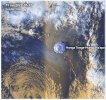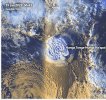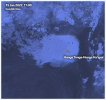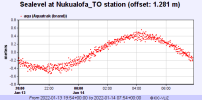You are using an out of date browser. It may not display this or other websites correctly.
You should upgrade or use an alternative browser.
You should upgrade or use an alternative browser.
Major Eruption of Undersea Volcano in Tonga
- Thread starter sToRmR1dR
- Start date
Presently Pat
A Disturbance in the Force
XPan
The Living Force
Hunga-Tonga Ha’apai Volcano, Tonga - Pacific Ocean
15 Jan 2021 • (133m / 436feet )
I believe something major has happened at the Hunga-Tonga Ha’apai Volcano - and I don't mean the big outbreak from yesterday on 14 January 2022 (actually 13 Jan) which was already large, but a new event this morning (European local time), something major must have happened. As I checked Windy.com after work early this morning - the eruption plume had just started to expand (at sunset, their local time) - and only hours later, it expanded to the size of Northern New Zealand.
I took screen captures of the (ongoing) event, as well a gif animation - which illustrates chillingly how the ash cloud expands, at the same time sends sort of "pressure wave" ripples through the neighboring clouds in a circle over 1600 km in diameter.
That is what let's me assume something far larger must have happened, just hours ago and still ongoing. So far, no reports from that event. But Vulkane.net wrote about the 13 Jan event (se below)




At german Vulkane.net, Marc Szeglat wrote
15 Jan 2021 • (133m / 436feet )
I believe something major has happened at the Hunga-Tonga Ha’apai Volcano - and I don't mean the big outbreak from yesterday on 14 January 2022 (actually 13 Jan) which was already large, but a new event this morning (European local time), something major must have happened. As I checked Windy.com after work early this morning - the eruption plume had just started to expand (at sunset, their local time) - and only hours later, it expanded to the size of Northern New Zealand.
I took screen captures of the (ongoing) event, as well a gif animation - which illustrates chillingly how the ash cloud expands, at the same time sends sort of "pressure wave" ripples through the neighboring clouds in a circle over 1600 km in diameter.
That is what let's me assume something far larger must have happened, just hours ago and still ongoing. So far, no reports from that event. But Vulkane.net wrote about the 13 Jan event (se below)




At german Vulkane.net, Marc Szeglat wrote
Hunga Tonga-Hunga Ha'apai: Eruption triggers small tsunamis
14 Jan 2022
For a few days it had been quite quiet around the island volcano Hunga Tonga-Hunga Ha'apai, but yesterday it reported back with a huge eruption. The volcanic eruption is so strong that small tsunamis arrive on the main island of Tonga. The wave heights are a little less than 60 cm. That may not be much, but even small tsunamis can push a few 100 metres inland and cause damage along the coasts. But there are no reports of this at the moment. In any case, the region is on tsunami alert. The height of the ash column is impressive: according to VAAC Wellington, it rose to almost 18,000 metres. The last detected eruption cloud still reached a height of 15,000 m.
Due to the expected air pollution, authorities advised residents of the archipelago to stay indoors and wear breathing masks outdoors. The strongest pollution is likely to come from the emitted sulphur dioxide at a greater distance from the volcano. However, ordinary masks, which are likely to be available in many households in Corona times, will not help against this. To filter sulphur dioxide, you need proper gas masks with special filters. Corona masks, or gas masks with included filters, usually help against dust, i.e. volcanic ash.
DeepL
Last edited:
Hunga-Tonga Ha’apai Volcano, Tonga - Pacific Ocean
15 Jan 2021 • (133m / 436feet )
I took screen captures of the (ongoing) event, as well a gif animation - which illustrates chillingly how the ash cloud expands, at the same time sends sort of "pressure wave" ripples through the neighboring clouds in a circle over 1600 km in diameter.
At german Vulkane.net, Marc Szeglat wrote
Some info i found on twitter:
From Himawari satellite (note they wrote the wrong year on the first tweet below, corrected later to 2022):
The waves, ash clouds, and ash-rain in Tonga:
XPan
The Living Force
Incredible !!! Thank you itellsya !!!
I usually don't check twitter and facebook, since I don't have an account and info is often limited for me to browse before they force stop me from scrolling down too much. But yeah, those are the places where info about earth changes first emerges, from people reporting through images and videos. It suddenly becomes literally so vivid...
There seem to have been two "pressure waves" in one of the satellite video clips (Himawari-8 satellite imagery via RAMMB) Boy, that must have been really violent...
Edit: I mean the first sound wave looks like it was 5000 km in diameter, visible in the satellite animation you referred to... That's... a little bit of Krakatoa deja'vu.
I usually don't check twitter and facebook, since I don't have an account and info is often limited for me to browse before they force stop me from scrolling down too much. But yeah, those are the places where info about earth changes first emerges, from people reporting through images and videos. It suddenly becomes literally so vivid...
There seem to have been two "pressure waves" in one of the satellite video clips (Himawari-8 satellite imagery via RAMMB) Boy, that must have been really violent...
Edit: I mean the first sound wave looks like it was 5000 km in diameter, visible in the satellite animation you referred to... That's... a little bit of Krakatoa deja'vu.
Last edited:
XPan
The Living Force
One of the eruption blasts hitting tonga, where people/teenagers are at the beach...
Some more footage of the tsunami hitting Tonga -
Last edited:
Hi_Henry
The Living Force
Amazing power of the Tonga volcano
Tsunami warning for Amami, Tokara
Japan's Meteorological Agency has issued a tsunami warning for the southern Amami islands and Tokara island chain in Kagoshima Prefecture and a tsunami advisory for wide coastal areas facing the Pacific Ocean. The highest tsunami observed so far is 120 centimeters in the Kominato district of Amami-Oshima Island at 11:55 p.m. on Saturday. And a 3-meter tsunami may reach coastal areas where tsunami warnings are in effect.
XPan
The Living Force
Spaceweather.com regarding the Tonga shockwave
The shockwave was recorded as a sudden uptick in air pressure as far away as Alaska, Belize and multiple locations in Florida. The global wave is expected to converge on southern Algeria, giving an especially strong signal there.
High-altitude balloon and satellite measurements indicate that the exhaust plume has reached the stratosphere, as high as 60,000 feet. Ash and sulfurous compounds spreading through the stratosphere could create unusual sunsets in the evenings ahead.
XPan
The Living Force
The video was posted on 14 Jan 2022, so it does not include any details of the major eruption from this morning of 15 jan 2022. He also assumes that the island is growing.
Well i saw a satellite image made at around 02.00 UTC today, showing that the large center part of the island - is completely gone. Only two remnants remain. I will post the images tomorrow morning when i am back from work.
Well i saw a satellite image made at around 02.00 UTC today, showing that the large center part of the island - is completely gone. Only two remnants remain. I will post the images tomorrow morning when i am back from work.
Nević Nenad
The Living Force
If that is sound wave from the explosion which is 30 kms far, that was one mighty explosion. Is there somewhere video of the shock wave? That would be also interesting to see.One of the eruption blasts hitting tonga, where people/teenagers are at the beach...
Videos of the Tsunami making it to California and Chile have started to appear on the internet.

